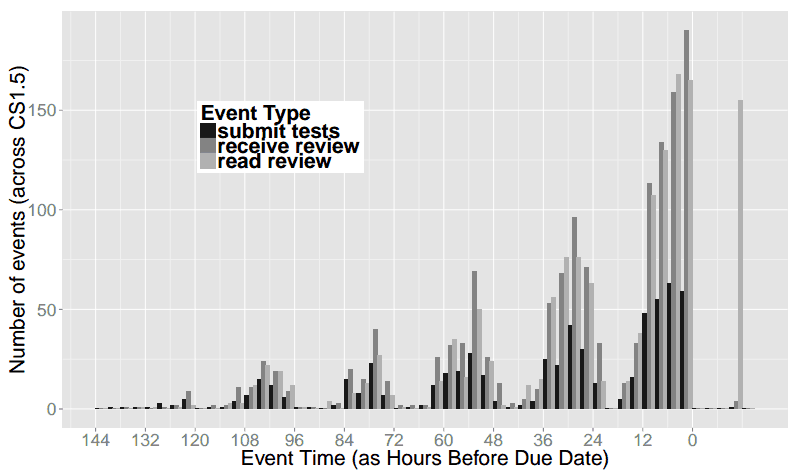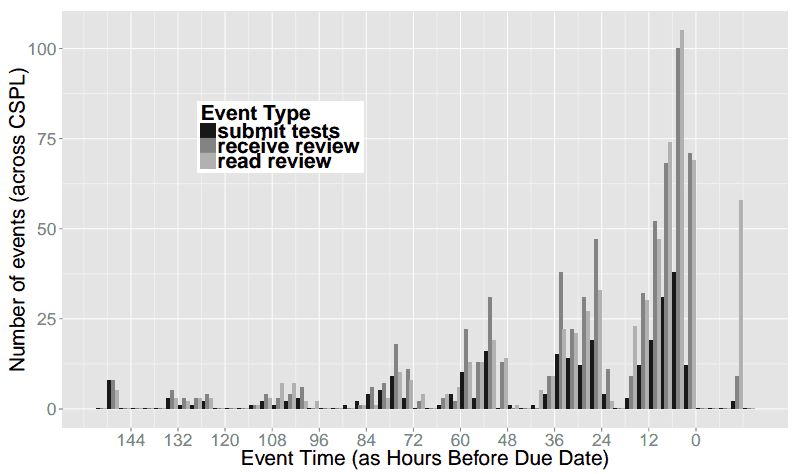CS Student Work/Sleep Habits Revealed As Possibly Dangerously Normal
Tags: Education, User Studies
Posted on 14 June 2014. Written by Jesse Polhemus, and originally posted at the Brown CS blogImagine a first-year computer science concentrator (let’s call him Luis) e-mailing friends and family back home after a few weeks with Brown Computer Science (BrownCS). Everything he expected to be challenging is even tougher than anticipated: generative recursion, writing specifications instead of implementations, learning how to test his code instead of just writing it. Worst of all is the workload. On any given night, he’s averaging –this seems too cruel to be possible– no more than eight or nine hours of sleep.
Wait, what? Everyone knows that CS students don't get any sleep, so eight or nine hours is out of the question. Or is it? Recent findings from PhD student Joseph Gibbs Politz, adjunct professor Kathi Fisler, and professor Shriram Krishnamurthi analyze when students completed tasks in two different BrownCS classes, shedding interesting light on an age-old question: when do our students work, and when (if ever) do they sleep? The question calls to mind a popular conception of the computer scientist that Luis has likely seen in countless movies and books:
- Hours are late. (A recent poster to boardgames@lists.cs.brown.edu requests a 2 PM start time in order to avoid being “ridiculously early” for prospective players.)
- Sleep is minimal. BrownCS alumnus Andy Hertzfeld, writing about the early days of Apple Computer in Revolution in the Valley, describes the “gigantic bag of chocolate-covered espresso beans” and “medicinal quantities of caffeinated beverages” that allowed days of uninterrupted coding.
Part 1: Deadline Experiments
The story begins a few years before Luis’s arrival, when Shriram would routinely schedule his assignments to be due at the 11:00 AM start of class. “Students looked exhausted,” he remembers. “They were clearly staying up all night in order to complete the assignment just prior to class.”
Initially, he moved the deadline to 2:00 AM, figuring that night owl students would finish work in the early hours of the morning and then get some sleep. This was effective, but someone pointed out that it was unfair to other professors who taught earlier classes and were forced to deal with tired students who had finished Shriram’s assignment but not slept sufficiently.
“My final step,” he explains, “was to change deadlines to midnight. I also began penalizing late assignments on a 24-hour basis instead of an hourly one. This encourages students to get a full night’s sleep even if they miss a deadline.”
This was the situation when Luis arrives. The next task was to start measuring the results.
Part 2: Tracking Events
Shriram, Kathi, and Joe analyzed two of Shriram’s classes, CS 019 and CS 1730. For each class, Luis must submit test suites at any time he chooses, then read reviews of his work from fellow students. He then continues working on the solution, eventually producing a final implementation that must be submitted prior to the midnight deadline.
Part 3: Reality And Mythology
Given these parameters, what work and sleep patterns would you expect? We asked professor Tom Doeppner to reflect on Luis and share his experience of working closely with students as Director of Undergraduate Studies and Director of the Master’s Program. “Do students work late? I know I get e-mail from students at all hours of the night,” he says, “and I found out quickly that morning classes are unpopular, which is why I teach in the afternoon. Maybe it’s associated with age? I liked to work late when I was young, but I got out of the habit in my thirties.”
Asked about the possible mythologizing of late nights and sleeplessness, Tom tells a story from his own teaching: “Before we broke up CS 169 into two classes, the students had t-shirts made: ‘CS 169: Because There Are Only 168 Hours In A Week’. I think there’s definitely a widespread belief that you’re not really working hard unless you’re pulling multiple all-nighters.”
This doesn’t exactly sound like Luis’s sleep habits! Take a look at the graphs below to see how mythology and reality compare.
Part 4: Results And Conclusions
The graphs below depict test suite submissions, with time displayed in six-hour segments. For example, between 6 PM and the midnight deadline (“6-M”), 50 CS 173 students are submitting tests.

This graph is hypothetical, showing Joe, Kathi, and Shriram’s expectations for submission activity. They expected activity to be slow and increase steadily, culminating in frantic late-night activity just before the deadline. Generally taller “M-6” (midnight to 6 AM) bars indicate late-night work and a corresponding flurry of submissions, followed by generally shorter “6-N” (6 AM to noon) bars when students tried to get a few winks in. Cumulatively, these two trends depict the popular conception of the computer science student who favors late hours and perpetually lacks sleep.


These graphs show actual submissions. As expected, activity generally increases over time and the last day contains the majority of submissions. However, unexpectedly, the “N-6” (noon to 6 PM) and “6-M” (6 PM to midnight) segments are universally the most active. In the case of the CS 173 graph, this morning segment contains far more submissions than any other of the day’s three segments. In both of these graphs, the “M-6” (midnight to 6 AM) segments are universally the least active, even the day the assignment is due. For example, the final segment of this type, which represents the last available span of early morning hours, is among the lowest of all segments, with only ten submissions occurring. In contrast, the corresponding “6-N” (6 AM to noon) shows more than four times as many submissions, suggesting that most students do their work before or after the pre-dawn hours but not during them.
“I wouldn’t have expected that,” Joe comments. “I think of the stories folks tell of when they work not lining up with that, in terms of staying up late and getting up just in time for class. Our students have something important to do at midnight other than work: they cut off their work before midnight and do something else. For the majority it’s probably sleep, but it could just be social time or other coursework. Either way, it’s an interesting across-the-board behavior.”
If word of these results gets out, what can Luis and his fellow students expect? “People will realize,” Shriram says, “that despite what everyone likes to claim, students even in challenging courses really are getting sleep, so it’s okay for them to, too.” Joe agrees: “There isn’t so much work in CS that you have to sacrifice normal sleeping hours for it.”
Luis, his family, and his well-rested classmates will undoubtedly be glad to hear it. The only question is: will their own descriptions of their work/sleep habits change to match reality, or are tales of hyper-caffeinated heroics too tempting to resist?
Appendix
The graphs above are simplified for readability, and aggregated into 6-hour increments. Below we include graphs of the raw data in 3-hour increments. This shows that there is some work going on from 12am-3am the night before assignments are due, but essentially nothing from 3am-6am.
In both of these classes, we were also performing experiments on code review, so the raw data includes when students read the code reviews they received, in addition to when they submitted their work. Since the review necessarily happens after submission, and the reading of the review after that, we see many more “late” events for reading reviews.
CS019 in 3-hour increments:

CS173 in 3-hour increments:

